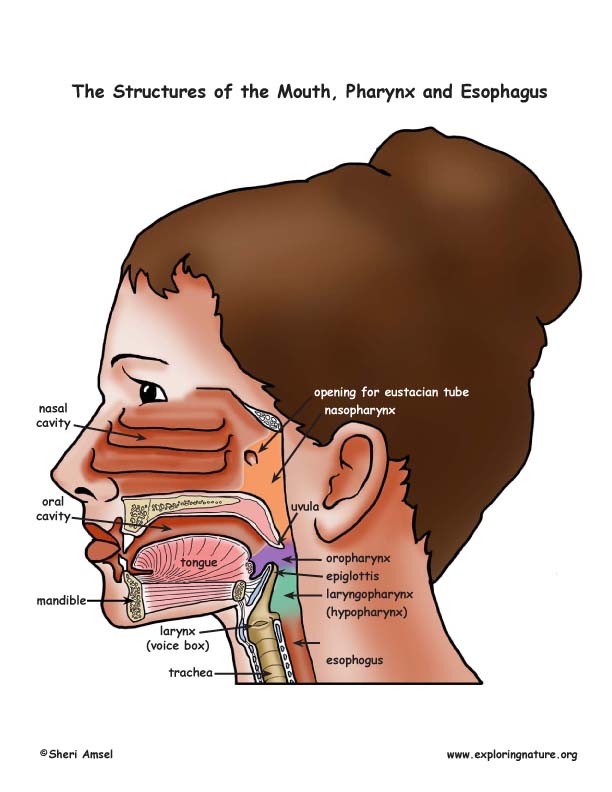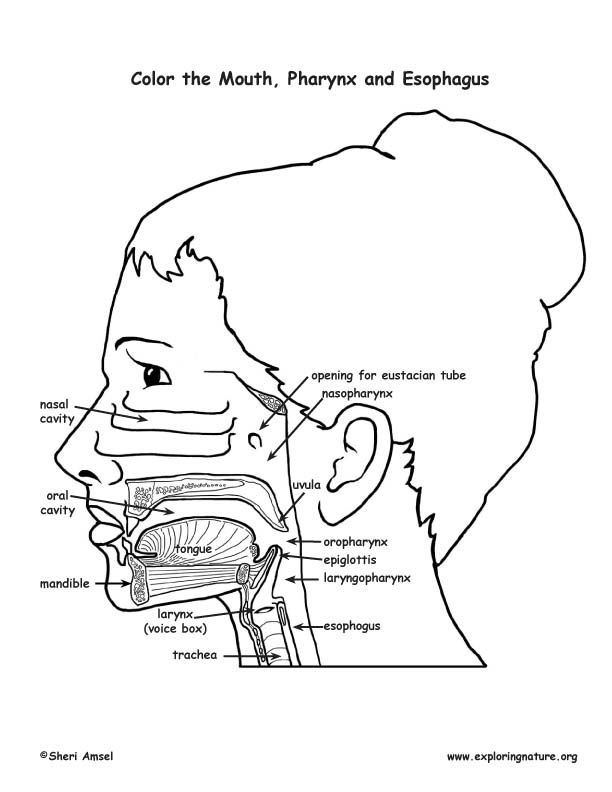

The mouth (oral cavity) is where digestion begins. In the mouth are the teeth, tongue and the salivary glands. The teeth chew the food. This is the beginning of mechanical digestion. The tongue moves the food around to help break it down and mixes it with saliva. Saliva is secreted by the salivary glands and begins the chemical digestion of starchy foods (like bread). Food is chewed and rolled into a bolus (lump) to be swallowed. When the food is swallowed, it passes through the pharynx (back of the throat) down into the esophagus. The pharynx is broken down into three parts, the nasopharynx at the back of the nasal cavity, the oropharynx at the back of the throat between the uvula and the epiglottis and the laryngopharynx (or hypopharynx) between the and the esophagus. The epiglottis is cartilage-filled flap that closes over the opening to the trachea when swallowing to prevent food from entering the lungs. The esophagus is a long, muscular tube about 10 inches long (25 cm). Food passes down it to reach the stomach. The muscles of the esophagus contract to squeeze the food downward. This is called peristalsis.
LS1.A Structure and Function
K-2 All organisms have external parts that they use to perform daily functions.
3-5 Organisms have both internal and external macroscopic structures that allow for growth, survival, behavior, and reproduction.
6-8 All living things are made up of cells. In organisms, cells work together to form
tissues and organs that are specialized for particular body functions.
9-12 Systems of specialized cells within organisms help perform essential functions of life. Any one system in an organism is made up of numerous parts. Feedback mechanisms maintain an organism’s internal conditions within certain limits and mediate behaviors.
When you research information you must cite the reference. Citing for websites is different from citing from books, magazines and periodicals. The style of citing shown here is from the MLA Style Citations (Modern Language Association).
When citing a WEBSITE the general format is as follows.
Author Last Name, First Name(s). "Title: Subtitle of Part of Web Page, if appropriate." Title: Subtitle: Section of Page if appropriate. Sponsoring/Publishing Agency, If Given. Additional significant descriptive information. Date of Electronic Publication or other Date, such as Last Updated. Day Month Year of access < URL >.
Amsel, Sheri. "Mouth, Pharynx and Esophagus " Exploring Nature Educational Resource ©2005-2024. December 14, 2024
< http://www.exploringnature.org/db/view/Mouth-Pharynx-and-Esophagus >


